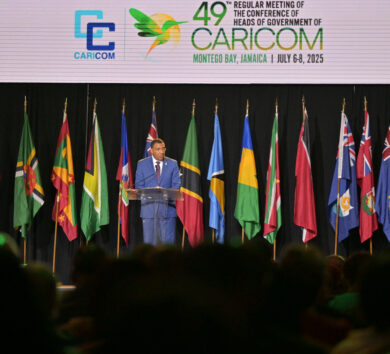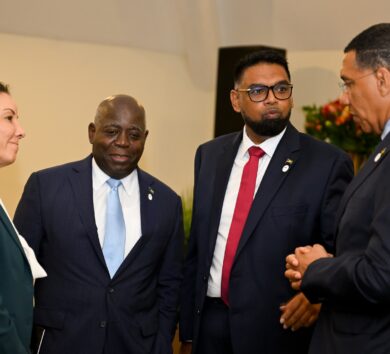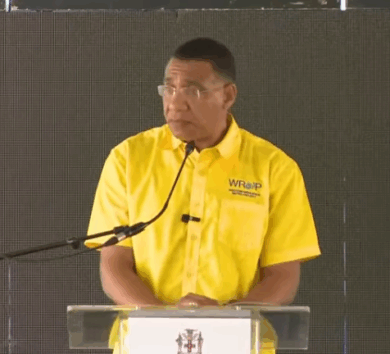

Prime Minister Andrew Holness outlined that Raintree Commercial Complex is a vision of how stakeholders move Jamaica from potential to progress, while emphasising that this transformation will serve generations.
He said the bold step to develop the Caymanas Estate Development Area (CEDA) reflects the very purpose for which the Urban Development Corporation (UDC) was established, which is to drive sustainable urban transformation in a way that balances development with environmental stewardship and social inclusion.
“This moment represents the fruits of patient coordinated planning by the Urban Development Corporation in partnership with government ministries, regulatory agencies, investors, and the communities surrounding the site. The Caymanas Estate Development Area, of which this Raintree development is a part, has long been earmarked as one of the most strategically valuable land banks in the Kingston metropolitan region, encompassing over 10,000 acres across the St Catharine, St Andrew boundary,” he said.
The area also sits at the convergence of three major highways, the Edward Seaga, PJ Paterson, and Nelson Mandela highways, giving it accessibility to Kingston, Spanish Town, Portmore, and other key logistics gateways.
“For decades, this land held potential. Today, we are converting that potential into progress. We are converting dreams into reality. So Raintree is the first phase of a wider transformation of over 3,400 acres of developable land in this critical area at the crossroads of Kingston, Portmore, and Spanish Town,” Holness added.
He said Block 1 alone encompasses 108 acres of subdivided land dedicated to commercial and light industrial development. “With today’s groundbreaking, we take the first definitive step in activating a space that has been zoned, master-planned, and environmentally assessed to support a new generation of enterprise and employment. It will deliver a much-needed supply of service, investment-ready lots in proximity to major roads and urban centres, fulfilling a market gap for modern commercial infrastructure outside of Kingston’s core.
“The vision is clear: create a space where businesses, large and small, can thrive in an environment supported by first-rate infrastructure connectivity and sustainability,” he continued.
Holness also stated that the Raintree Commercial Complex is projected to attract capital investment of at least J$3.8 million in infrastructure and will support long-term private investments exceeding J$15 million.
“During construction, we expect 2,000 jobs to be created. And over the long term, this complex has the potential to accommodate more than 5,000 permanent jobs, many of which will be in high-growth sectors, such as business process outsourcing, logistics, manufacturing, warehousing, and other commercial activities.
“As such, this project represents real opportunities for people. Yes. I can see the welders, the technicians, the engineers, the administrative staff, the ICT professionals, and small entrepreneurs. This is how we translate our economic gains into better lives for the people. The over $15 million of projected private investment on this site, driven by the sale of the development lots, will have a multiplier effect feeding directly into the local economy, creating demand for jobs, services, housing, and transportation,” he added.
Holness also alluded to the fact that development works best when it generates self-reinforcing cycles of opportunity and progress. We are creating a virtuous cycle of peace, productivity, and prosperity. To further increase productivity, we are reducing bureaucracy and improving the ease of doing business in Jamaica. This will enable businesses to thrive, and we will attract even greater investment and keep this virtuous cycle of peace, productivity, and prosperity going.”
He added: “I want to assure the stakeholders who are advocates for the environment that the government is sensitive, and we believe that you must never trade off your environmental assets at the altar of economic progress. We also believe that with deep respect for the environment, but with the embrace of technology and understanding local customs and people, we can usually find a happy equilibrium, where we can be good stewards of the environment and, at the same time, secure economic benefits for our people.
“The error we make is in believing that our environmental assets can be secured in poverty. Poverty is one of the greatest threats to our environmental assets. So as a nation, we have to figure out this very complex equation of how do we use our environmental assets, protect them and preserve them, and at the same time reduce poverty,” he continued.
Environmental preservation methods implemented to develop the Raintree Commercial Complex
Holness said the infrastructure works permitted by the Natural Resources Conservation Authority (NRCA) are comprehensive and forward-looking. “The internal road network will adhere to both local and international standards. The drainage system has been designed to maintain the natural hydrology of the area with careful attention to water quality and habitat preservation. A modern sewage system will connect to the Soapberry Water Treatment Plant, which will be expanded,” he said.
He also outlined that a portable water supply will come initially from the National Water Commission (NWC) and then later from Caymanas.
“Fire safety has been factored in with hydrants placed throughout the development. Electrical infrastructure will be provided by JPS under a coordinated plan, and landscaping will ensure that this commercial zone is not only functional but also environmentally pleasing and respectful of the green spaces around it.
“This development has taken into account the environmental and social realities of the space. The Caymanas Estate contains wetlands and forested areas of ecological significance. Accordingly, over 50 per cent of the overall master plan will be preserved in green spaces. Extensive environmental assessments, including flora and fauna studies and large tree surveys, were conducted to mitigate any negative impacts. These measures are not only regulatory requirements; they reflect our national commitment to responsible and sustainable development,” Holness added.
On the social side, the prime minister said the UDC engaged the Social Development Commission (SDC) to conduct baseline economic surveys of nearby communities, particularly the Caymanas village and ferry.
“The area is home to nearly 230 residents, and the UDC has taken deliberate steps to minimise displacement and disruption. Notably, 27 farmers who were cultivating land here have been identified, consulted, and offered relocation to nearby zoned agricultural plots under new licensing arrangements. That is what people-centred development looks like—building with people in mind,” he said.






Comments